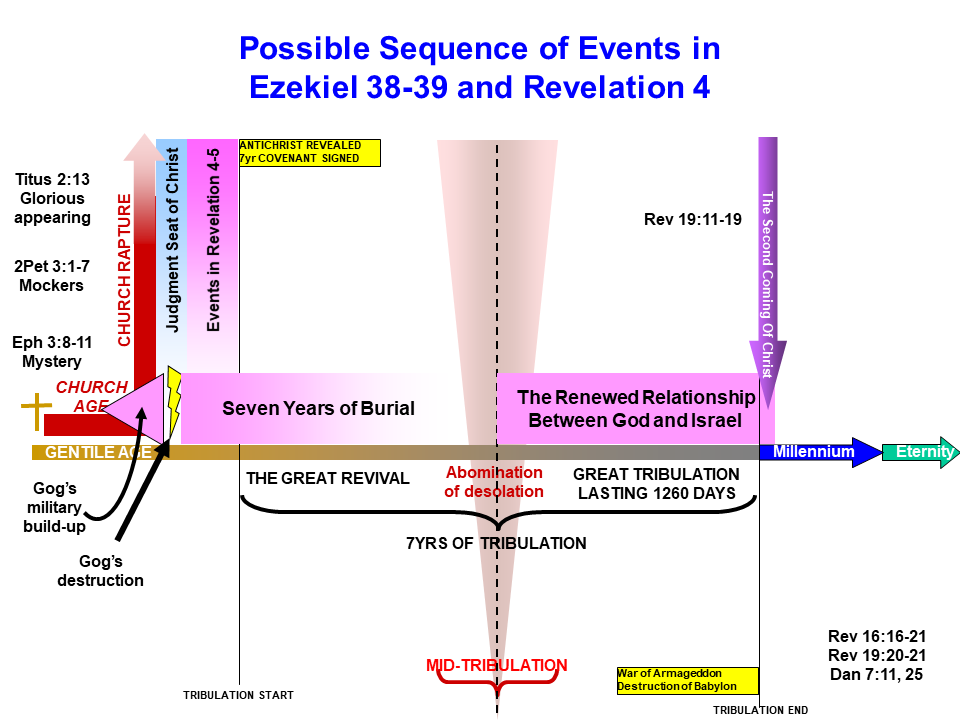Timelines: General Survey of the Timelines Used in this Website
The basis for all the timelines used on this web site build on a simple horizontal bar, as seen in the following graphic. This bar graph depicts the Gentile Age that begins at the time King Nebuchadnezzar first defeated Jerusalem. A thorough understanding of the book of Daniel provides the context for understanding prophecy throughout the Bible for many reasons.
First, the Lord revealed to Daniel, King Nebuchadnezzar, and to all peoples, His plan for the ages. Beginning with Daniel 1:1-21, Daniel is carried away captive as a young boy, with other well learned and skilled Jews from Jerusalem to Babylon. After three years of training, the young man Daniel and his friends completed their Babylonian training and were matriculated within the a system of advisors to the King. Then Daniel 2:1-49 provides tremendous revelations concerning the rise and fall of major kingdoms beginning with Babylon, then its defeat to her enemy, the Medes and Persians. This was portrayed by an awesome image of a man in a dream of King Nebuchadnezzar, beginning with a head of gold, and ending with feet mixed with clay and iron. This is reflected in the chart below by the color of the horizontal bar transitioning from a gold color to a color of iron. Only four kingdoms are identified in this prophesy and the revealed prophetic timeline was truncated beginning with King Nebuchadnezzar's military conquests. No other kingdom in that region such as Assyria, Egypt, or other great historical kingdoms, was part of this march in time of important kingdoms that defined the beginning of the Gentile era.
Second, though the northern tribes of Israel had already been taken captive by the Assyrians much earlier than Nebuchadnezzar's conquest against Judah, only the Babylonians gained complete dominance over the land of Judah and Jerusalem. An important key to understanding prophecy is to know that the land of Israel was promised to Abraham and his descendants, Genesis 15:7, 18-21, the people of Israel are the apple of God's eye, Zechariah 2:8 and the temple is where He chose to meet with His people Israel, 2Chronicles 6:5-6. The times when other great world dynasties existed such as China, Mayans, or other great societies on other continents in the world are not considered to define the Gentile era since they neither trampled underfoot, nor controlled or significantly influenced the affairs in Jerusalem.
Third, Jerusalem is another important key to understanding prophecy. This is brought out in the prophetic timeline revealed to Daniel by the angel Gabriel, Daniel 9:21-25, in which the 70 prophetic weeks of years (490 years, see this discussion in this site on Daniel 9) begins with the order to restore and rebuild Jerusalem's walls and streets, not just the temple. In Daniel 2:36-38, the era of the Gentiles began with the three military campaigns of King Nebuchadnezzar against Jerusalem, and this era will not end until the return of Jesus Christ to establish His millennial kingdom, as shown in Revelation 19:11-21 with the Lord's return and the Lord's eternal reign on earth as shown in Revelation 20:1-15.
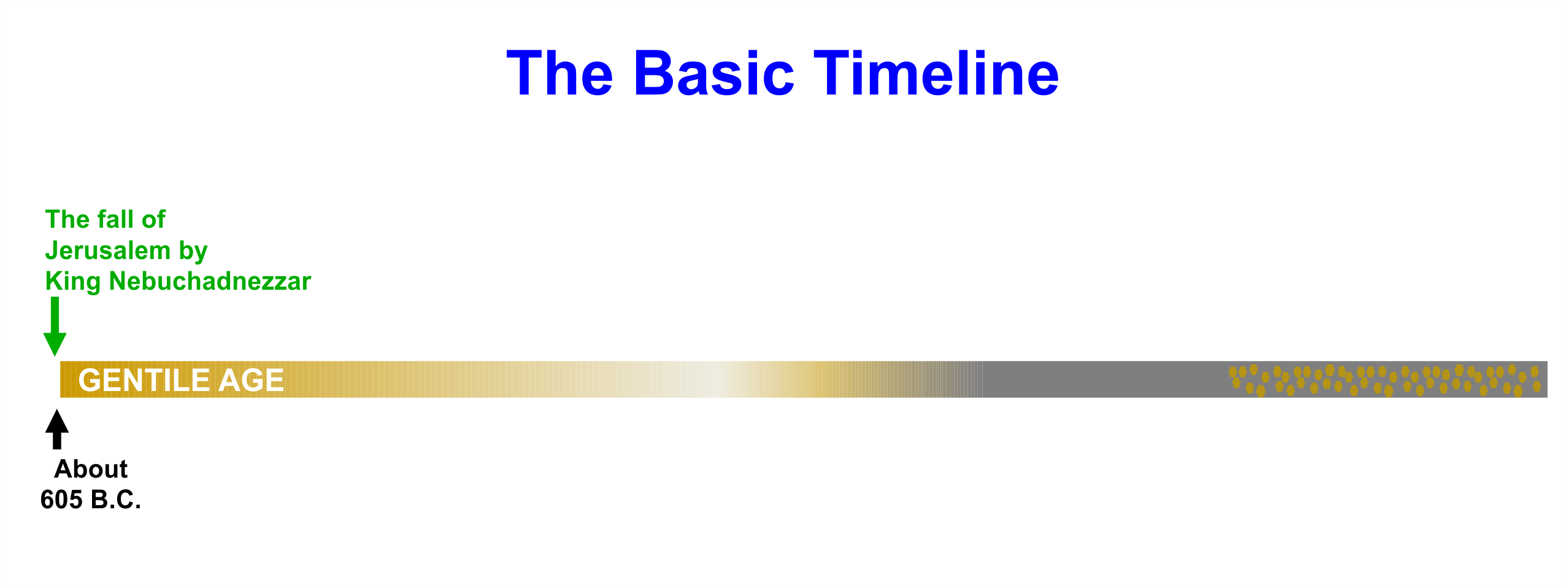
The following graphic shows the timeline that builds upon the basic timeline above that is used in this web site with all the prophetic passages in the books of Daniel, Ezekiel, the gospels according to Matthew, Mark and Luke, and with 1Corinthians 15, 1Thessalonians, 2Thessalonians and Revelation. There are important dates included on the timeline below to illustrate when the times of the Gentiles occurred, the approximate date of the Lord's crucifixion, the date when the Jews began to be dispersed from their land to all corners of the world by the Romans, and when Israel became a nation again. All of these dates, and others are important in understanding prophecy.
The graphic also exposes the days that we live in within the context of the prophetic timeline, which is the church age. The church age will continue until the day that the Lord calls the church to come up to Him in the clouds. On that day, the saints in the body of Christ will be resurrected and those living will be raptured to be with the Lord for eternity. There may be a period of time between that event and the beginning of the tribulation. That event is signaled by the Lord opening the first seal on a scroll with seven seals, and by the Antichrist signing a seven year covenant with Israel.
The end of the seven years of the tribulation will occur with the second coming of the Lord Jesus Christ with all His saints at the battle of Armageddon. Thereafter will be the 1,000 year reign of the Lord with His saints, then Eternity future. Between the Millennial reign of Christ and the period of eternity future, there will be the great white throne judgment, where the unrighteous will be judged by God, and thrown into the lake of fire for eternity.
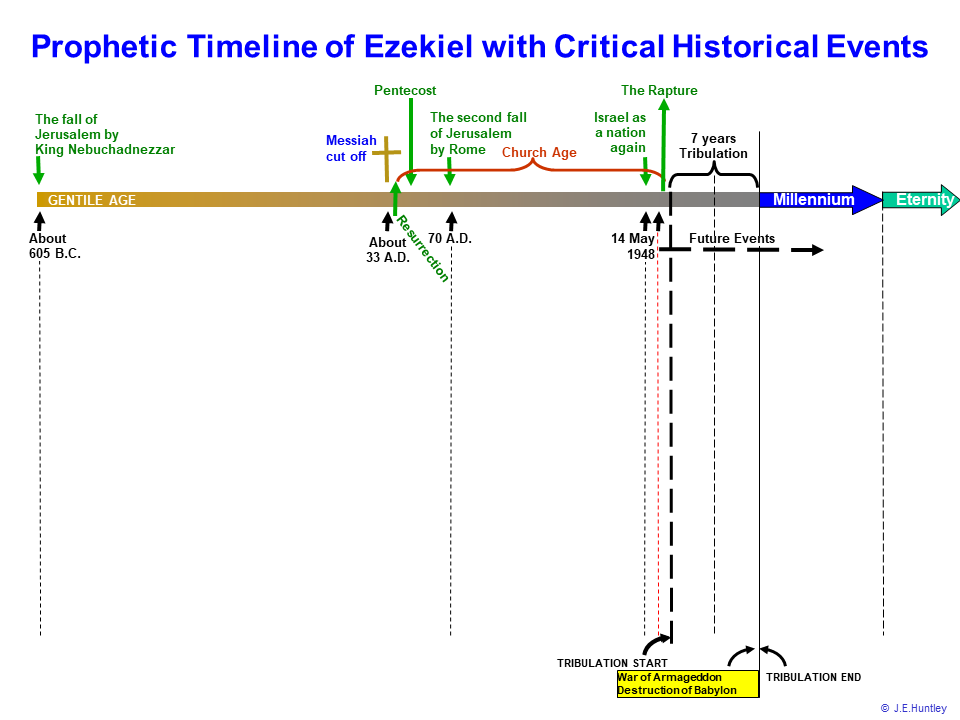
The following timeline further builds upon the 'Prophetic Timeline with Critical Historical Events' timeline above and illustrates critical historical events and prophetic events yet to occur relative to the church age. The church age is the period of time that began on the day Jesus Christ rose from the dead, and breathed the Holy Spirit upon the 10 apostles who were hiding in an upper room, John 20:19-22. The church age will end with the rapture of the church, 2Thessalonians 2:1-8. The date when this site was updated is still within the church age, and serves as a reference point to much of what is written in this website. As shown in the Lord's first earthly ministry, He had said Jerusalem would continue to be trodden down by the Gentiles until their time was fulfilled, which is at the end of the seven years of tribulation at the battle of Armageddon occurs. This is the time of the Lord's return for His second advent. However, unlike His first advent when He appeared as a humble servant and as a lamb for the slaughter, at His return He will be the King of kings and Lord of lords. In Revelation 5:1-14, the Lord is shown and referenced both as the slain lamb and the Lion of Judah. The end of the Gentile age is shown in the timeline below by the solid red arrow from left to right below the yellow oval with the scriptural reference to Luke 21:20-24, and above the quotation of the scripture that appears in the yellow box. The right arrow head indicates the fulfillment of the Gentile age. For more information on the Gentile age, follow the link to another of this site's web page where you will find written, what constitutes the age of the Gentiles.
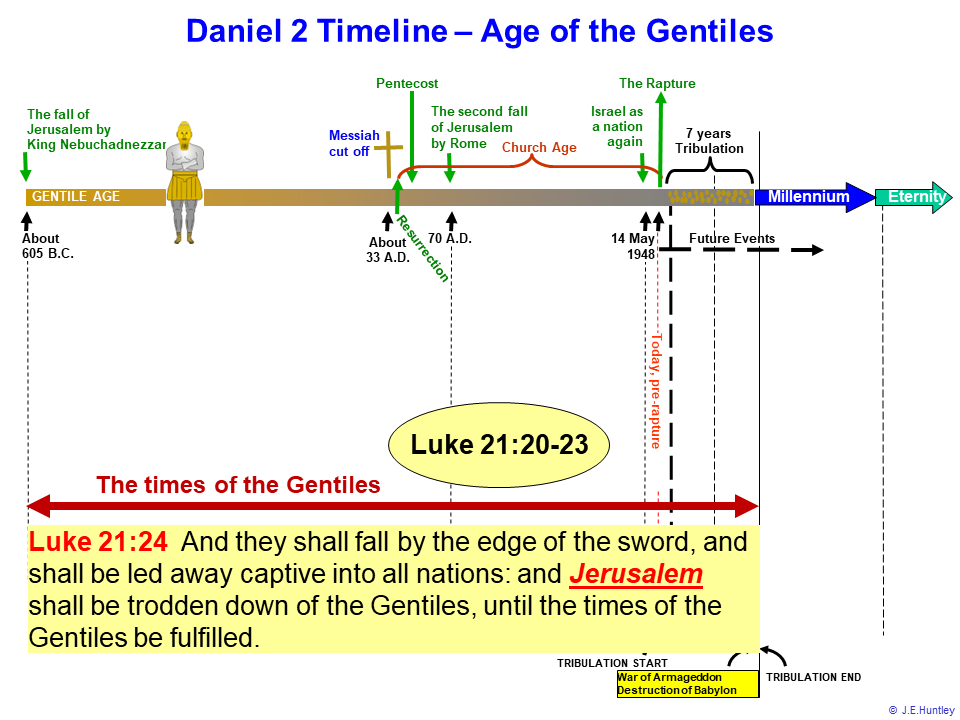
Though the following chart is an aggregation of charts in the book of Daniel from chapter 1 through chapters 11 and 12 and appears complex, the intent of pushing this graphic to this section of the website is to illustrate how this website treats many of the prophetic events revealed throughout scripture and how they are illustrated against the backdrop of other historical events on the timeline above. The intention for this method of presentation is to aid the reader to better comprehend each event in the context of other historical or prophetic events. Also, as the reader progresses through the pages on this website that examines several prophetic books in the Bible such as the book of Daniel, the events are explored and identified on the timeline. As each new event is studied it is added to the chart and the timeline becomes an aggregation of all the prior events for that book of the Bible being studied. For example, the following chart began by showing the prophetic events revealed in Daniel 2 that covered the entire prophetic timeline. In contrast, events revealed in each of the chapters beginning in Daniel 7 through Daniel 12 are represented in smaller segments on the timeline. As evident in the graphic below, Daniel 7 highlights the seven years of tribulation, Daniel 8 address the events that affect the nation of Israel, and introduces the transition from the Medo-Persian empire to the Grecian empire. Daniel 9 reveals the 70 weeks that God had determined on Israel, which are broken up into three segments. The first segment is associated with the rebuilding of the temple. The second segment points to the time when Israel's Messiah would present Himself, and be rejected by them. It also identifies the people who would destroy Jerusalem, and from whom the Antichrist would arise. The third segment is the final prophetic week. The 70th week is not contiguous with former 69 weeks. A pause is inferred in this passage, and elsewhere, between the 69th week and the 70th week in the prophetic timeline. This is illustrated at the bottom of the graph with the reference to Hosea 6:1-2, which shows that there is a 2,000 year span between the 69th and 70th week. Daniel 10 and much of Daniel 11 show the impacts on Israel from the type of Antichrist who appeared during the Grecian empire and performed many despicable and evil things upon them. He was not conquered by men, but his death was from God. At the end of Daniel 11, the Antichrist of the tribulation is introduced. Daniel 12 then shows the return of Christ to the earth.
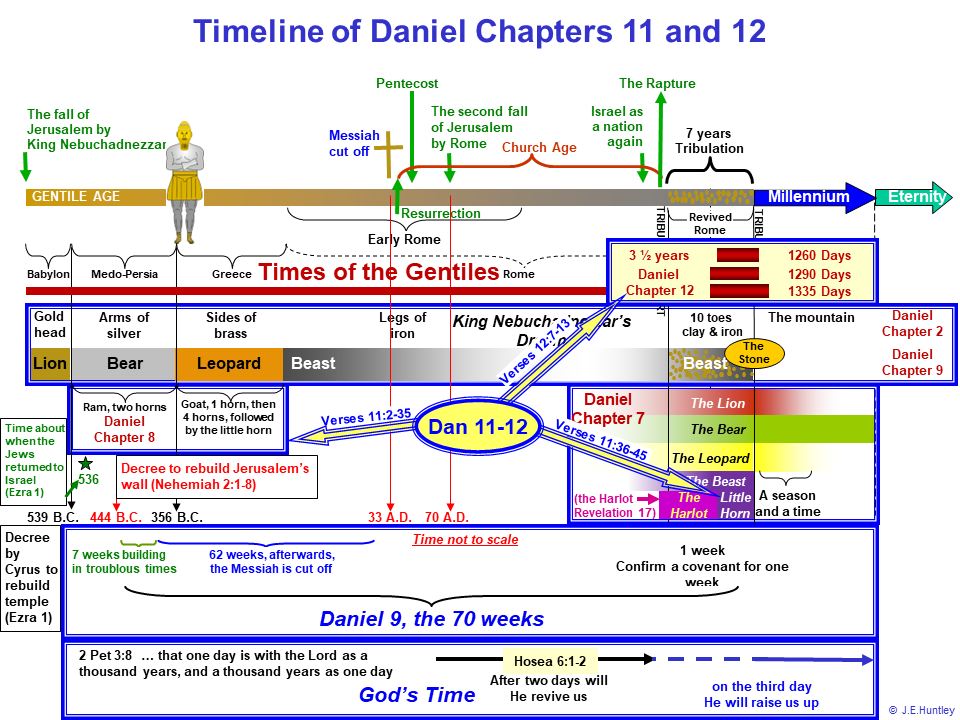
The following timeline further builds upon the 'Prophetic Timeline with Critical Historical Events' timeline above and illustrates critical historical events and prophetic events yet to occur relative to the church age. The church age is the period of time that began on the day Jesus Christ rose from the dead, and breathed the Holy Spirit upon the 10 apostles who were hiding in an upper room, John 20:19-22. The church age will end with the rapture of the church, 2Thessalonians 2:1-8.
Traditional teaching concerning the church age is that the seven churches identified in Revelation 2:1-29 and Revelation 3:1-22 are directly representative of the church age. This is manifest in many ways, such as each of the churches indicate a period of history in the church age, or that each church in revelation represents a characteristic of a current churches’ spiritual state. This was the teaching of previous versions of this site. However, upon more reflection on the beginning of the church age, and its overall structure as recorded by Luke in the book of Acts, it is now believed that the church age is more represented by the following graph. It shows the church first being represented by the “little flock” and completely Jewish in nature and membership, as described in the dispensation of law: The Remnant. When Israel fell, salvation came to the Gentiles, Romans 11:11, led by the apostle Paul, and then the Jewish church diminished Romans 11:12 (KJV). From then on, the church was comprised of Jews and Gentiles in the Body of Christ, 1Corinthians 12:13, 27. This church has grown and continues this day, until the snatching away (rapture), for the Body-of-Christ to meet the Lord in the clouds. This all occurs during the dispensation of grace, in which the revealed mysteries given to Paul are in effect, and is reflected in the graphic below, within the area above the red bar labeled church age, and left of the vertical bar labeled church rapture. Right of the vertical red bar is the list of the reconstituted Jewish churches, who will then pass through the tribulation.
The mystery program will end once the church is taken up. From then on, God’s prophetic program for Israel will resume, shown in the graph below in the brown horizontal arrow, which becomes the dispensation of the kingdom. The seven letters to the seven churches, are addressed to the Jewish believers in the prophetic program. Those believers are promised that they who overcome and endure through the tribulation will have a part in the Lord’s kingdom, Matthew 10:22, as elaborated in Revelation 2:1-29 and Revelation 3:1-22.
Superimposed below the horizontal gold to iron bar labeled Gentile age, are green arrows, that represent the vision given to Ezekiel about the dry bones. During the church age, after the destruction of Jerusalem in 70 A.D., saw Israel as just dry bones, with no chance of ever attaining life, Ezekiel 37:1-2. However, the Lord told Ezekiel to prophesy over the bones, and the bones rightly joined together and flesh came upon them, which in the chart below begins when Israel became a nation. But as a nation, they have not accepted Jesus as their Messiah, so they remain spiritually lifeless. It is not until the middle of the tribulation, when they see the image of the Antichrist erected in the holy place in their tribulation temple that will be built, that they will realize the lie they had followed and their spiritual blindness will be removed. That is when their flesh will become full of life, Ezekiel 37:9-10, as they flee into the wilderness to meet the Lord there, Matthew 24:15-21, Revelation 12:1-6. After the Lord returns physically to sit on David’s throne, Israel will enjoy the promises of the kingdom that were given to them, Ezekiel 37:22-28.
The apostle John detailed characteristics of the glorified Christ Jesus, Revelation 4-19. In the letter to each church, each church is shown to be associated with a subset of the Lord’s characteristics, to build them up, encourage them, or introduce a warning of judgment in preparation of the tribulation. In turn, these seven churches collectively reflect much of the glory of Christ Jesus. The book of Revelation is written to prepare the believing Jews for the tribulation they will go through, the worst time in human history, Matthew 24:21. These seven churches are Jewish synagogues, that reflect Israel’s past. The seven churches likely existed under John’s ministry, but they are in ruins now because the prophetic program has been paused until the end of the mystery program. After the rapture of the Body-of-Christ, these seven churches will be reconstituted, almost immediately. Soon, after the passage of an undescribed period of time, the 70th week described to Daniel, will been. That is initiated with the Lord opens the first seal of the seven sealed scroll, Daniel 9:24-27, Revelation 6:1.
John, as the apostle to the circumcision, Galatians 2:7-10, described what he saw as he wrote the book of Revelation. The finished book was then delivered to the churches that existed in John’s day, and they are for the churches as they are reconstituted, after the rapture of the Body-of-Christ, Revelation 1:19.
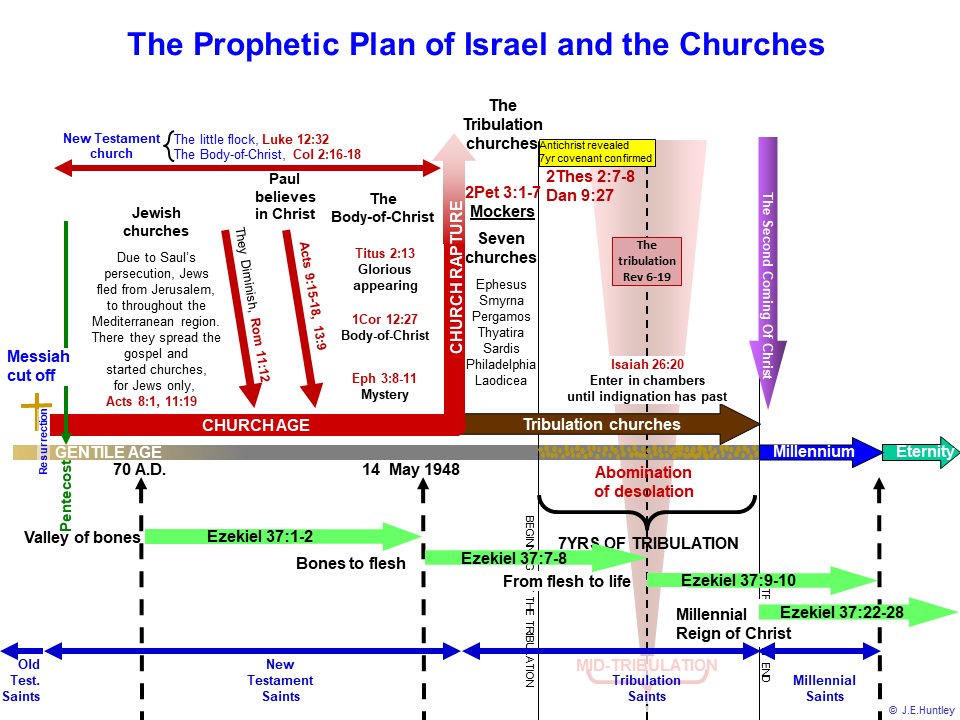
Some commentators erroneously teach that the church is a replacement for the nation of Israel with respect to promises God made to Israel that have yet to be fulfilled. Nothing can be further from the truth. As one reviews the latter chapters of Ezekiel, there is a plethora of promises that are very specific to Israel. If God were to modify any of them, then what assurance does the church have that the Lord would keep His word to them? Examining even one chapter, Ezekiel 37, shows the building relationship between the Lord and Israel during the church age, into the millennial reign of Christ. The previous graphic illustrates how, in the example of the valley of bones, that God assembles the bones and puts flesh on them, representing the rebirth of the nation of Israel. An important point to be drawn from this example is that as Israel was brought back together as a nation, there is no spiritual life until the time they will meet the Lord in the wilderness. Thereafter, they will also rule with the Lord Jesus Christ during His millennial reign. As can be seen above, the Lord is now working in Israel to fulfill all that He had promised them.
During the Lord's first earthly ministry, He told His disciples many things regarding the coming destruction of Jerusalem, of the tribulation that is yet to occur, and of His coming kingdom. Most of His discussion on this occurred while he taught on the Mount of Olives, which is why it these teachings are called the Olivet Discourse, Matthew 24:1-51, Matthew 25:1-46, Mark 13:1-37, and Luke 21:1-38. However, some teaching on these subjects occurred at other times as explained in this site in the examination of Luke 17:1-37. The Lord warned His disciples, and to the church through them, to expect an increase in natural and manmade troubles that the world would experience as time marched toward the beginning of the tribulation. As shown in the next graphic, there is a building up of the number of occurrences, duration, and intensities in the natural violence and wars that men would suffer with the approach of the seven years of tribulation.
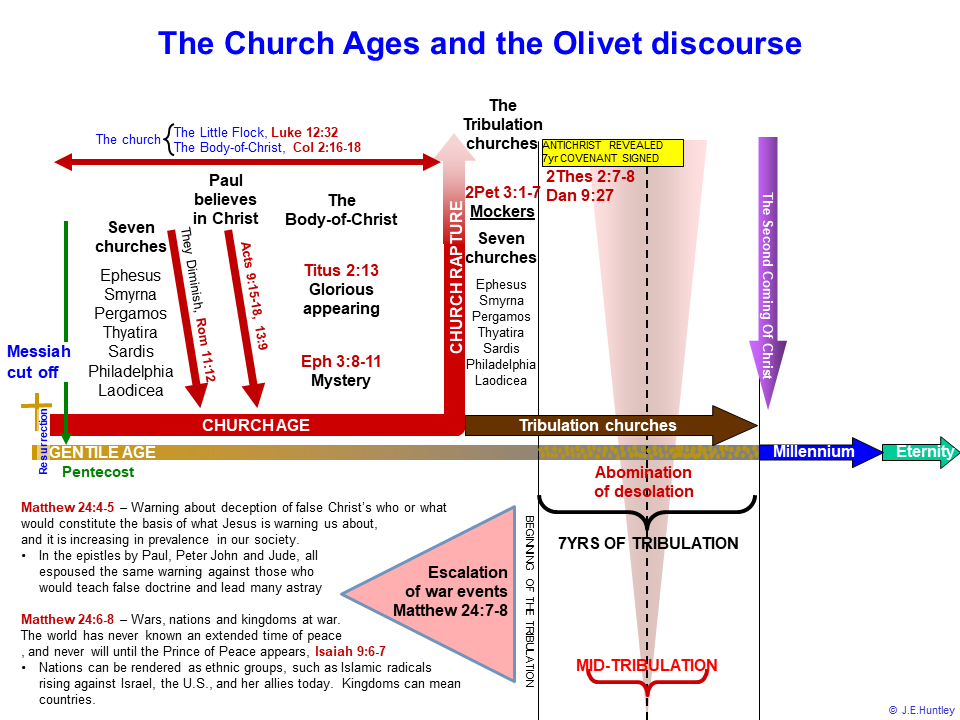
The next chart is a summary of the words of the Lord to John, instructing him to write the things that he has seen, the things that are, and the things that shall be, Revelation 1:19. As can be seen below, the church age falls within the category of "the things that are." The rapture of the church is what falls under the term used by the Lord, "hereafter" as translated in the King James Version (KJV). Again, the difference between this chart and the previous one, is the expansion of the timeline for the period covering the church age. This is done for purely chartmanship reasons to avoid clutter, and to enhance clarity in the description of the churches.
In Revelation 1:19, the Lord instructed John to write the things that he had seen (his witness of Christ’s first advent), the things that are (the church age), and the things which will be hereafter (the tribulation, millennial reign of Christ, and the future eternity). There are three distinct periods of time that was given by the Father, Revelation 1:1, Acts 1:6-7. These three periods concern Israel and the church. The first period is related to the time that John observed and participated in the Lord’s earthly ministry, 1John 1:1-4. The second period is the things that are, or the church age. The letters to the seven churches in Asia show that this period is related to the church age. The final period, which indicates a future event relative to the church age, is the transition into the opening of the tribulation. The phrase “hereafter” is the same word in Greek to that used in Revelation 4:1 to reinforce this relationship, that the church is removed, or raptured, prior to the things “hereafter,” which is the tribulation. This is illustrated in the following graphic where the "things you have seen" align with the events surrounding the cross, the "things that are" are aligned with the church age, and the "things that shall be" are aligned with the future events following the rapture of the church, which is the "hereafter."
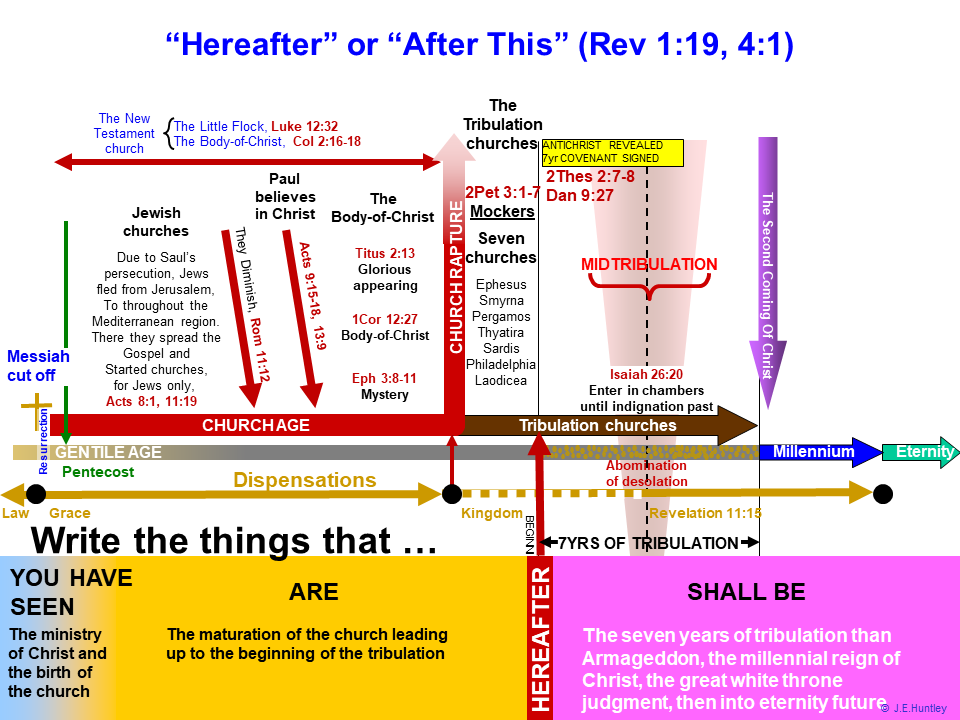
Following the church age, the next series of events described in the book of Revelation are associated with the tribulation period. What are shown in the following graphic are two events not explicitly discussed in Revelation, but are described in Ezekiel 38:1-23 and Ezekiel 39:1-29, which is the invasion of Israel by Gog and his confederates. The implied timing on the following graphic is not a viewpoint that is reached by a consensus or a majority of those teaching the premillennial viewpoint. However, it is the viewpoint that is taught on this site. The events prophesied in Ezekiel will likely occur immediately after the rapture of the church. The following graphic also shows the simultaneous appearance of the church before the judgment seat of Christ, 2Corinthians 5:6-10. Again, there are many alternative views among commentators on the sequence of these events, particularly with the invasion of Israel, but this is the sequence of events used in this site in developing the overall timeline from now through the end of the tribulation.
With all of the details given in Ezekiel 38:1-23 and Ezekiel 39:1-29, the following graphic attempts to capture them in a general sense. There is a build up in activity between the God, or Russia, and its Muslim confederates. Though there are battle plans drawn up to invade and destroy Israel, they are not pursued until some cataclysmic event occurs. This event may be the rapture of the church, or other natural or manmade catastrophe. Nevertheless, Russia and its confederates will realize an opportunity to take advantage of and quickly position their forces in Northern Israel to invade her. This battle is the Lord's. Though the invading forces are prepared for an all out attack, neither the invaders nor Israel will launch any type of weapon. Instead, the Lord will rain all types of judgment upon Israel's enemies and utterly destroy them and their homeland. Thereafter, it will take about seven years to bury the remnants of the dead. Afterward, a remnant of Israel will have a revived relationship with the Lord Jesus Christ, their Messiah, which is depicted as a solid purple rectangle in the last half of the seven years of the tribulation, and on into the Millennial reign of Christ over this world.
